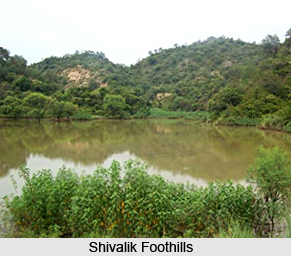 History of Hoshiarpur District mentions that this district was also a part of Indus Valley Civilization. Recent excavations at various sites in the district have revealed that the entire area near the Shivalik foothills was selected for habitation not only by the early Paleolithic man but also by those in the historic periods. In the explorations, seven early Stone Age artifacts have been found. Besides these excavations, among the archaeological remains in Hoshiarpur District, the remains of temples at Dholbaha, 24 km north of Hoshiarpur, and especially the local legends throw light on the ancient history of the district.
History of Hoshiarpur District mentions that this district was also a part of Indus Valley Civilization. Recent excavations at various sites in the district have revealed that the entire area near the Shivalik foothills was selected for habitation not only by the early Paleolithic man but also by those in the historic periods. In the explorations, seven early Stone Age artifacts have been found. Besides these excavations, among the archaeological remains in Hoshiarpur District, the remains of temples at Dholbaha, 24 km north of Hoshiarpur, and especially the local legends throw light on the ancient history of the district.
The legends associate several places in the district with Pandavas. From the Shivalik frontal range in Hoshiarpur District, 16 sites have been reported to have yielded Stone Age tools. The archaeological excavations carried out at Dholbaha, situated at a distance of about 30 km to the north-west of Hoshiarpur; reveal its relationship with the pre-historic period. This area has been a place of habitation right form the very early times; the archaeological discoveries have related its antiquities to the Pleistocene period. Presence of fossils and beautiful sand stone sculptures of medieval period underline the importance of Dholbaha and tend to establish the fact that Dholbaha valley was occupied by the affluent iconolatry at various intervals.
According to the medieval history of Hoshiarpur District, the plains of the present Hoshiarpur District probably came under the Mohammedan rule on the fall of Jalandhar in 1088 AD but the hills, however, remained under the Hindu Chieftains. It is said that before the first Mohammedan invasion, Raja Shankar Das built a fort on the site of the present town of Garhshankar, but it was taken by Mahmud Ghazni and subsequently given by Emperor Shahab-ud-Din Ghori to Man Singh of Jaipur. The whole of the Shivalik Hills along with the principalities of Ghuram, Hansi, Sarusti, Samana and other tracts were subjugated by Sultan Muhammad Ghori.
During the return journey of Amir Taimur from Delhi in 1398-99 AD, the district faced a great devastation. Taimur wished to capture Nagarkot, but did not penetrate so far in the interior of the hills. The Hindu Rajas gave him tough fight. He passed through Bajwara and Dasua in the district. In 1432 AD, Mubarak Shah transferred Jalandhar and Lahore from the charge of Nusrat Khan to that of Malik Allahabad Kaka Lodhi. Lodhi, who was yet on his way to Lahore to take over the charge, was attacked by Jasrat, who was compelled to seek shelter at Kothi situated between Jaijon and Mahalpur about 16 km to the south of Bajwara in Hoshiarpur District. Jaijon in the Hoshiarpur District was once the seat of Jaswal Rajas. After the death of Aurangzeb in 1707, Punjab was divided into six Doabs. Jalandhar Doab had 69 Mahals. In this Doab, the most important towns, falling in the Hoshiarpur District, were Sham Churasi, Tanda, Mukerian and Hoshiarpur.
Further, history also states that Hoshiarpur District was annexed by British at the close of the First Anglo Sikh War. John Lawrence became the first Commissioner of the trans-Satluj states in March 1846, and the division was administered by him in direct correspondence with the Supreme Government until 1848, when the Commissioner was made subordinate to the Resident at Lahore. When the Second Sikh War began in 1848, the Rajas of Jaswan, Kangra and Datarpur revolted against the British rule. The Sepoy Mutiny, 1857 did not affect Hoshiarpur District. However, a number of precautionary measures were taken by the British authorities.
Unpopular policies of the British government raised a political storm in Punjab including Hoshiarpur District. With a view to stimulate the political activities in Punjab, District Congress Committees were set up in all the districts. Accordingly, the District congress committee, Hoshiarpur was formed in 1917. The delegated of this Committee attended the Provincial Political conference held at Lahore the same year. The District Congress committee, Hoshiarpur arranged a public meeting at Hoshiarpur on 23 July 1920 in favour of Non Cooperation Movement. The Indian National Congress passed the Quit India Resolution on 8th August 1942. Thus, history of Hoshiarpur District shows that this district played a significant role in the freedom movement of the country.



















